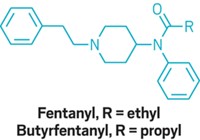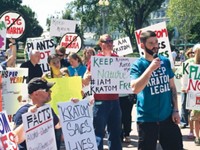Advertisement
Grab your lab coat. Let's get started
Welcome!
Welcome!
Create an account below to get 6 C&EN articles per month, receive newsletters and more - all free.
It seems this is your first time logging in online. Please enter the following information to continue.
As an ACS member you automatically get access to this site. All we need is few more details to create your reading experience.
Not you? Sign in with a different account.
Not you? Sign in with a different account.
ERROR 1
ERROR 1
ERROR 2
ERROR 2
ERROR 2
ERROR 2
ERROR 2
Password and Confirm password must match.
If you have an ACS member number, please enter it here so we can link this account to your membership. (optional)
ERROR 2
ACS values your privacy. By submitting your information, you are gaining access to C&EN and subscribing to our weekly newsletter. We use the information you provide to make your reading experience better, and we will never sell your data to third party members.
Safety
Synthetic drug traffickers outpace U.S. laws, senators say
Hundreds of new substances lack controls, pose threats
by Glenn Hess, special to C&EN
June 9, 2016
Chemists’ capabilities to tweak the structure of synthetic drug molecules are outrunning the ability of legislators and law enforcers to control illegal substances, U.S. senators said at a June 7 hearing. They called for Congress to do more to fight synthetic drugs that are flowing into the U.S. while evading federal control efforts, they added.
For years, law enforcement officials have struggled to stay a step ahead of those who produce and distribute illicit synthetic cannabinoids and cathinones. More recently, a third category of synthetic drugs has emerged as a concern: synthetic opioids, in the form of fentanyl and its derivatives. Fentanyl, the drug reported to have led to musician Prince’s death in April, is also sold legally as a prescription drug in the U.S.
“The criminals who manufacture these synthetic drugs are constantly modifying the formula in order to produce technically new drugs that are not included in our criminal code, making it exceedingly more difficult for law enforcement to hold them accountable,” Sen. Patrick Leahy (D-Vt.) said at the Senate Judiciary Committee hearing.
According to the Drug Enforcement Administration (DEA), synthetic drugs are largely manufactured outside the U.S., mostly in China. They enter the country illegally through the mail—some can be ordered online—or are smuggled across the southern border with Mexico.
“Federal agencies are working closely with China and other countries to reduce the production of these substances,” said Michael P. Botticelli, director of the White House Office of National Drug Control Policy, told the Senate Judiciary Committee. The Administration, he added, is also working with the chemical industry to monitor and track the manufacture of synthetic drugs and their precursor chemicals.
“While this committee acted a few years ago, it’s clear the traffickers are continuing to outpace us,” said Sen. Charles Grassley (R-Iowa), Judiciary Committee chairman. “This is a difficult problem without easy answers.”
In 2012, Congress passed the Synthetic Drug Abuse Prevention Act. That law placed a series of synthetic cannabinoids on Schedule I of the Controlled Substances Act. That designation makes it illegal to
manufacture, possess, sell, or distribute the compounds.
The bill also gave DEA authority to temporarily place certain synthetics on Schedule I to protect the public. Other Schedule I drugs include heroin and ecstasy.
“This was an important step to help protect our young people. Calls to poison control centers began to level off or decline for a time,” Grassley noted. But calls for synthetic marijuana have once again begun to spike, rising from 2,668 in 2013 to 7,779 in 2015, according to the senator.
“Clearly, the threat posed by these drugs has not abated,” Grassley said. Noting that new synthetic substances continue to pop up, he said law enforcement officials have “identified hundreds of new substances that are candidates for some type of control.”





Join the conversation
Contact the reporter
Submit a Letter to the Editor for publication
Engage with us on Twitter